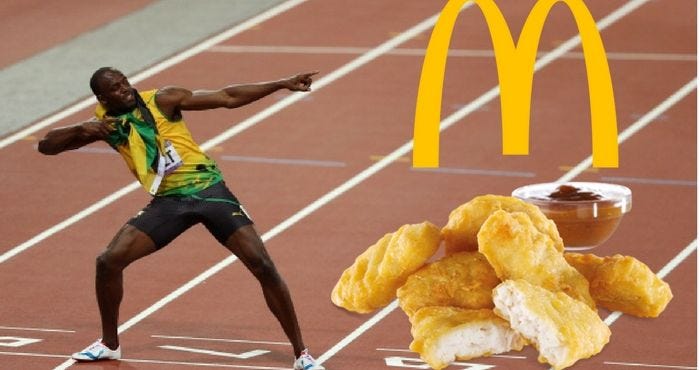How can 'Usain Bolt eating 1,000 Chicken McNuggets' Shape Your Compensation Strategy
And it is not a question of taste...
Usain Bolt, recognized as the fastest man on Earth, made headlines during his ten-day stay at the 2008 Beijing Olympics by consuming an astonishing 1,000 Chicken McNuggets—100 nuggets per day. The driving force behind it? Not the taste, But Bolt's relentless pursuit to minimize uncertainty and enhance his performance.
“They were the only food I could properly trust which wouldn’t affect my stomach. On arriving at the [pre-Olympic] training camp I’d tried a local Chinese meal, which wasn’t like the ones we we eat in the West, and my body didn’t react well. So, knowing I could rely on nuggets, I made up my mind that was all I would eat. And eat them I did, for breakfast, lunch and dinner, washed down with bottled water.”
By mitigating the risk of falling ill, Usain Bolt significantly enhanced his chances of victory. Whether you label it risk aversion or uncertainty avoidance, one thing is certain: it's deeply ingrained in human nature and serves as a powerful motivator.
Now back to the sales world.
A salesperson's primary duty is to sell. While some may argue that their role extends beyond this function (see here and also here), for many, including their own organizations, the core objective is revenue generation. As a result, compensation plans are meticulously crafted to align with this mission. These plans come in various forms, including commission-only structures, salary plus commission models, tiered commission systems, and those based on profit or gross margin. Additionally, Sales Program Incentive Funds (SPIFFs) are occasionally implemented as short-term incentives to motivate sales representatives toward specific objectives, such as depleting inventory or promoting new solutions.
Frequently, SPIFF programs are accompanied by conditions or criteria, such as deal value thresholds. From the company's standpoint, this practice is sound for two distinct reasons, each with its unique nature. Firstly, it's a strategy to optimize the SPIFF budget. When an organization introduces a SPIFF to promote a particular product or solution, setting a minimum deal value serves as a means to maximize the effectiveness of the allocated budget. This rationale is a deliberate and conscious choice.
Conversely, the second reason is a bit more complex and potentially influenced by cognitive bias. SPIFF discussions and planning typically occur at the headquarters (HQ) level. The larger the organization, the more it tends to perceive data through a macro lens rather than a micro one. At the international HQ of a company, the tendency to think in terms of averages is heightened. One of the most common tools for analyzing data at a macro level is the 'average.' It's a familiar concept, easy to understand, and simple to use. Yet, it's like the fast food of metrics: convenient, but lacking depth and substance. Furthermore, it's crucial to recognize that the concept of an 'average deal size' is elusive, especially in the complex world of B2B sales.
Let's engage in a little thought experiment: Are 8x1 and 1x8 equal? From a mathematical, corporate, or macro perspective, the answer is a resounding YES. In both cases, you're generating 8 million dollars in sales revenue. However, when we shift our lens to sales team management and motivation, the story takes a different turn.
Consider this: having eight salespersons each signing a 1 million-dollar deal isn't equivalent to having one salesperson signing an 8 million-dollar deal. The distinction runs deeper than the numbers alone. This contrast should raise several critical questions, although we'll save that for another discussion.
Now, let's dive into the world of SPIFFs. Imagine you're keen on introducing a SPIFF program based on an average deal size of 2 million dollars. The SPIFF offers a generous 0.1% of the deal value as a reward. Here's the scenario: a salesperson has signed four deals, collectively amounting to 8 million dollars.
Scenario 1: In this instance, each deal is worth 2 million dollars. The breakdown looks like this: 2M + 2M + 2M + 2M = 8M. The SPIFF totals $80K.
Scenario 2: Now, consider an alternate situation where the deals are valued at 3 million dollars and 1 million dollar in alternating order: 3M + 1M + 3M + 1M = 8M. However, due to the SPIFF's eligibility criteria, only two deals qualify, resulting in a SPIFF of $60K.
How do you justify a 25% decrease in the reward when the company enjoys the same revenue? One might naturally assume that the amount of effort invested was consistent in both scenarios – four deals, after all.
When it comes to designing a SPIFF program, it's undeniable that factoring in all the variables, scenarios, and regional specificities is a daunting task. This complexity is an inherent challenge. However, amidst the intricacies, one must never lose sight of the essence of a SPIFF and its fundamental purpose: to encourage and reward actions that benefit the company, particularly those not easily accomplished.
After all, that's why SPIFFs exist, isn't it? The goal is to motivate and recognize accomplishments. The truth is, sealing a deal, regardless of its monetary value, is never a walk in the park. If you think that the ease of closing a deal is inversely proportional to its value, meaning that smaller deals are simpler to secure, it might be time to rethink that perspective.
In the realm of sales, one common adversary looms large, and it's something that people in general, including salespeople, intensely dislike – uncertainty. It's a formidable obstacle that can dampen motivation and disrupt productivity. To illustrate, consider the innovation brought forth by Uber. Yes, it made hailing a ride more convenient, but its true genius lay in reducing the uncertainty of the waiting time. The live tracking map provided reassurance and predictability, ensuring that riders knew precisely when their ride would arrive.
Similarly, in the context of waiting for a train, knowing that it will arrive in 7 minutes because the arrival time is clearly announced is undeniably comforting. Compare that to the anxiety of waiting for 5 minutes without any information about when the train will arrive. The human inclination to favor reduced uncertainty and minimized risk is deeply rooted in our behavior.
Even in the world of athletics, as exemplified by Usain Bolt and his seemingly unconventional diet in preparation for competitions, the desire to minimize uncertainty and enhance performance remains a driving force. Bolt's 1,000 Chicken McNuggets may seem bizarre, but at its core, it was a strategy to ensure his body's predictability and reduce the risk of potential illness.
In summary, whether in sales or everyday life, the quest to diminish uncertainty and mitigate risk is a fundamental aspect of human behavior. The success of SPIFF programs hinges on acknowledging and addressing this innate trait, which drives salespeople to achieve their goals while keeping uncertainty at bay.
When crafting a SPIFF program, one critical objective should be to prevent the emergence of frustration, anger, or other negative emotions among your sales team – outcomes that are undeniably counterproductive. The key to achieving this lies in reducing uncertainty from the salespeople's perspective.
The most effective approach to accomplishing this is by acknowledging and rewarding every individual who has successfully closed a deal, regardless of the deal's size. It's tempting to compare this strategy to giving out free t-shirts to all participants in a race, regardless of whether they win, whether it's a 2km, 5km, or 10km race. But our case is distinctly different – it's akin to presenting a 'FINISHER' t-shirt to those who complete the race, who achieve the objective of selling something.
Have you ever noticed how people proudly wear 'FINISHER' t-shirts from races, even if they didn't secure the top spot? The reason is clear: finishing the race is a significant accomplishment in itself. In the context of SPIFF programs, you're essentially acknowledging the challenges tied to the task and rewarding the individuals who meet those challenges.
Within the framework of a SPIFF scheme, you can certainly introduce tiers of compensation to reward the top performers. However, it's equally important to reward all the achievers. This balanced approach not only recognizes individual efforts but also significantly diminishes the uncertainty salespeople may feel regarding whether or not they will receive a reward for accomplishing their objectives.
It's noteworthy that rewards within a SPIFF program need not always be financial. Consider this – when you've invested $700 or more to participate in an event like an Ironman race, covering expenses for transportation, accommodation, and dedicating countless hours to rigorous training over several months just to ensure you cross the finish line, a t-shirt is much more than a mere $20 or $50 item. It becomes a token of your unwavering dedication, a tangible form of acknowledgment for your remarkable achievement.
In conclusion, when you embark on the journey of designing a SPIFF scheme, always keep your primary objective in clear focus: to reward achievers, by all means necessary. After all, achievers are those who cross the finish line, regardless of their speed. Losing sight of this fundamental point can transform your well-intentioned motivation tool into a source of demoralization and frustration, which is certainly not the desired outcome.
This is especially crucial when the foundation of your scheme relies on a potentially misleading use of 'average.' In the world of B2B sales, the concept of an 'Average Deal Size' is the 'Unicorn' of Metrics – it's rarely seen and often a mirage. Relying too heavily on averages can lead to misinterpretations of market dynamics and, in turn, flawed compensation strategies.
It's essential to remember that studies consistently show that financial rewards, while highly appreciated, are not the sole means to boost self-esteem and create a sense of recognition. At the end of the day, the primary goal remains constant: to eliminate the uncertainty of whether or not individuals will receive their well-deserved recognition, regardless of the form it takes. So, as you navigate the world of SPIFF programs, strive to create a culture of achievement and recognition, where every finisher – every achiever – receives their moment in the spotlight. In doing so, you'll not only enhance motivation but also cultivate an environment where individuals are inspired to consistently push the boundaries of their own performance.






